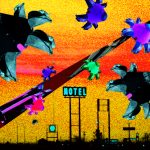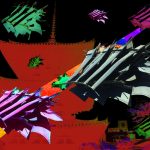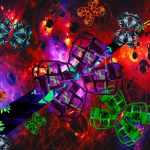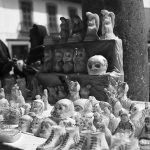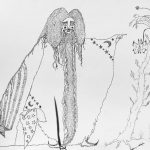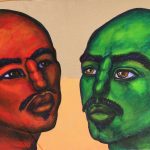
- This event has passed.
OPENING RECEPTION: ‘Remixing Reality: Art, Identity & Beyond’ curated by Sofia Gutierrez Calderon
@ 7:00 PM - 10:00 PM

Opening Reception: Saturday, July 13, 7-10PM
Exhibition Dates: July 13 – August 3, 2019
Closing Gathering: Saturday, August 3, 2-4PM
RSVP HERE
Please join us for the opening reception of ‘REMIXING REALITY: ART, IDENTITY & BEYOND,’ curated by Sofia Gutierrez Calderon, on Saturday, July 13, from 7-10PM. Admission is free, light snacks & refreshments will be available for a $2-4 donation, valet parking will be available for a $5 donation, or we are located walking distance from the Highland Park Metro Gold Line Station! We hope you can make it!
Show Statement:
Frida Khalo, nevertheless, is still the artist (along with Posada) who best reminds us that what was codified by the French Surrealists has always been our daily bread in Mexico and Latin America, part of the cultural current, a spontaneous fusion of myth and fact, dream and walking, reason and fantasy. The books of Gabriel Garcia Marquez and what has come to be called “magical realism” are the contemporary images of this reality. And the great contribution of the Hispanic spirit, from Cervantes to Borges and from Velazquez to Kahlo, is the certainty that the imagination is capable of founding, if not the world, at least a world. – CARLOS FUENTES
Mexico City (Mexica-Tenochtitlan) was the capital of the Aztec Empire, later to become in 1535 the capital of New Spain (La Nueva España), in the New World. Mexico City (La Ciudad de Mexico), since the seventeenth century, has been one of the largest and most important cities in the world. As stated by Ilona Katzew: “It was strategically located at the crossroads of major commercial routs connecting Spain, Asia, and the Americas: it was at the center of the East-West route that joined the Atlantic and the Pacific, Europe and Asia in a world economy.” In Mexico City, peoples from widely diverse backgrounds and wealth intermingled and mixed: Spaniards, creoles (Spaniards born in the Americas), Indians, mestizos, Africans, and foreigners, giving the city its lore and constructing tradition. El Pueblo de Nuestra Señora de Los Angeles founded in 1781, belonging to the Viceroyalty of New Spain, far away from its capital Mexico City, was just as complex.
Los Angeles, today in the 21st century, is a mirror of this past self. Drawing from this rich mix of culture, tradition, storytelling, art, and the supernatural: REMIXING REALITY, explores this non-linear narrative and identity, in this new “magical realism” we call LA.
SOFIA GUTIERREZ CALDERON
Featuring works by:
Alicia Sterling Beach
Ismael de Anda III
Carolyn Castano
Juan Manuel Idelfonso
Beatriz H. Jaramillo
John C. Lewis
Ricardo Reyes
Victor Solis
Beatriz Valls
Alicia Vogl Saena
Aren Williams
- Carolyn Castaño
- Beatriz H. Jaramillo
- Beatriz H. Jaramillo
- Beatriz H. Jaramillo
- Ismael De Anda III
- Ismael De Anda III
- Ismael De Anda III
- Ismael De Anda III
- Ismael De Anda III
- Ismael De Anda III
- John C. Lewis
- John C. Lewis
- Juan Manuel Ildefonso
- Juan Manuel Ildefonso
- Juan Manuel Ildefonso
- Juan Manuel Ildefonso
- Ricardo Reyes – NFS
- Ricardo Reyes – NFS
- Ricardo Reyes – NFS
- Ricardo Reyes – NFS
- Ricardo Reyes – NFS
- Victor Solis
- Victor Solis
- Alicia Sterling Beach
- Alicia Sterling Beach
Alicia Sterling Beach
I am making these drawings because they give me relief from incessant, urban noise and tumult, this capitalist and technological state, which increasingly separates us from Nature. Without Her, I am nothing. Without Her, you are nothing. Oxygen. Water. Life. Yet lifestyle and consumer trends in the US keep us, more and more, from Her, thinking otherwise, that we are above, entitled, worthy of escape, not having to clean up our trash, living in denial about our effects on climate…when I slow down and draw, I remember Her again. I feel more grounded, deliberate and calm. With Her, I am blessed and giving, a well-spring of flower bouquets for the world.
Instagram: artinveryhome.
Ismael de Anda III
(b. El Paso, Texas) lives and works in Los Angeles, California.
Using mutant practices including installation, drawing, painting, sculpture, and relational, interactive projects inspired by the history of minimal and conceptual art and social sculpture, my work focuses on re-interpretation of memory, inhabitation, and cultural history inspired by my pluralistic existence growing up on the hinge of the U.S./Mexico border and within the diverse realm of Los Angeles.
My work utilizes the concept of the mutant as a strategy to spontaneously, improvisationally, and wildly re-create and make ruptures and departures within notions of cultural definitions and experiences for art. My personal concept of the mutant a condition of unexpected evolution was born from reading (as an adolescent) X-Men comics that featured mutant outsiders/anti-heroes whose mutations special abilities that set them apart,and my own Mexican-American/Tejano ethnicity in the resource of my grandfather’s farm where I experienced wonders of biologically- mutated livestock as new breeds. My work is influenced by my upbringing with science fiction culture and growing up in the U.S. Southwestern desert, a region known for the testing of rocket and space flight technology. I have also been considering Gene Roddenberry, the creator of Star Trek, who like me was born in El Paso, Texas. I’m interested in how his sci-fi cosmology has inspired young inventors, scientists, and engineers to turn fantasy into existing contemporary technology.
The term “mutant” not only refers to my mixing of artistic processes, but also to the multi-ethnic existence of those living in the United States and the discomfort some feel when viewing a new type of authenticity that is not “true” to any one culture. This blending, mixing, and nuance creates the “mutant” concept that exists as a force of its own pushing the viewer to absorb, re-process, and re categorize concepts related to kitsch, stereotypes, and “the ugly.” This possibility for pluralistic existences further underlines my understanding of the “mutant” reality in which many of us reside.
Carolyn Castano
As a visual artist, my practice has focused on painting and drawing with a supporting practice in video. My most recent bodies of work are all encounters with themes and images originating in our hemisphere’s narco-trafficking milieu and armed-conflicts, with a particular emphasis on how gender and ecological concerns play out therein. The work mixes materiality with content in pieces that consider how the Latin American body and the Latin American landscape remain inextricably linked, even as their surrounding media and political contexts are increasingly digitized and globalized.
My most recent body of work, Mujeres Que Crean/ Women Who Create, is a mixed-media project featuring video, animated drawings, and a digitally printed curtain, based on an original drawing.
Mujeres Que Crean/ Women Who Create features displaced survivors of Colombia’s armed-conflict re-enacting poses and gestures found in historical artworks. Set against drawn tropical landscapes inspired by 18th century botanical illustrations of the Magdalena river valley, the video explores the role of women as mothers, sisters, and children of the armed-conflict, their human stories of loss and resilience underscored by the decline of the fragile ecologies surrounding the rural towns they fled.
Beatriz H. Jaramillo
Beatriz H. Jaramillo was born in Colombia where she received a BA in Fine Arts from Los Andes University. After moving to Los Angeles, where she now lives, she attended Cerritos College studying Ceramics and later received a MA in Art Education and a MFA in Studio Art with emphasis in Ceramics form California State University Los Angeles. Her work has been exhibited at Avenue 50 Studio, Cerritos College Art Gallery, AMOCA, the Kellogg Art Gallery at CalCaliPomona, Redondo Beach Power Plant, the Luckman Gallery at CSULA, Proyecta Gallery and Espacio Alterno Gallery in Bogota. She is currently serving as a teaching artists for the City of Commerce and Los Angeles County Museum of Art, as well as gallery educator for the Norton Simon Museum.
John C. Lewis
John has been a photographer and visual artist for over 30 years. His passion to create compelling images is evident in the distinctive way he sees and captures his subjects. He earned his BFA in 1982 from the Brooks Institute of Photographic Art & Science. In 2007 he was honored a Masters Degree for his lifetime commitment to the field of professional photography.
Much of John’s personal work is in Mexico, whose people and culture have inspired some of his most creative explorations with the camera. Since the 1980s he has participated in major group exhibitions in Mexico organized by the National Council for Culture and Arts (CONACULTA) and by the National Institute of Anthropology and History (INAH). In the US, John has shown in solo, collective and benefit exhibitions chiefly in museums and galleries in Florida, Georgia, Texas and California.
In addition to public and private collections of his work, The J. Paul Getty Museum, The Museum of Fine Arts, Houston, The Witliff Collection of Southwest and Mexican Photography, The Museum of Ventura County, and Kodak Mexicana include his photographs in their permanent collections. Notable awards include Agfa and UNESCO for his work on world heritage sites and top distinction from the Ilford Film Company in their “Silver Competition” for the traditional black and white processes. He is listed in the publication “Who’sWho in Visual Art
– 100 Fine Art Photographers” (ISBN 978-3-9813474-2-5)
Juan Manuel Ildefonso
My artwork explores the syntheses of cultures as part of a larger dialogue about identity and belonging. As the first-born son of immigrant parents, I spent much of my youth trying to escape the culture of my family in order to integrate—and it was encouraged. I’m interested in exploring my Oaxacan roots as they intersect with my upbringing in the South Central neighborhood of Los Angeles during the 1980s. I belong to many cultures and many traditions; I cannot claim one exclusively and none would definitively claim me as their own.
Ricardo Reyes
Since I first learned to value my roots as a Mexican American, I began to take inspiration from the many icons found in Mexican Culture and history. I drew from this source an almost stereotypical influence and used stereotypical icons at first. Soon, I abandoned this to develop my own artistic/cultural language exploiting other symbols to express my ideas.
This evolved and continued through the years of my artistic experience and still continues. When I wrote my book, “The Dreamers”, I fused many influences into the content of my story.
This is a story of magic set in a magical place, but full of the reality of human conflict, not unlike that experienced by Odysseus, in “The Odyssey” by Homer or Sita in “The Ramayana”, or Snow White, in “Snow White and the Seven Dwarfs”, a very old fairytale.
I drew from a conscious awareness of the meaning of some symbols and then began to use new symbols that came from an experience described by many writers called, “automatic writing”. This process which can only be compared to a trance-like process that feels as if you are possessed by a force that dictates the story to the writer. This is how my story, “The Dreamers”, became a reality.
I illustrated the book using the technique of stiple and eventually in 2005, published the book with the great support of my friends, Caroline West and Andrew West, who became my publishers.
In the 1990’s, I did several bas relief pieces where I used my symbols in three dimensional forms.
The painting of “Icarus and the Minotaur” reflect my keen interest in Greco-Roman mythology. Nothing could be more Mexican than that when we look at artists like Diego Rivera and Jose Clemente Orozco who were also influenced by the same myths to create some of their greatest works.
My influences include German fairy tales, the Brothers Grimm, Hans Christian Andersen and world mythology. I take symbols from all of these sources, including Mexican ones to create the art I create whether it be painting or writing.
Victor Solis
I feel that myth, fable, fantasy and “visual poetry” forge a persistent and vital part of who I am as a Latino artist. It is through these fantastic tools, that not only define me, but allow my work to be nourished and identified using images that are layered with symbols, shapes and colors. I am able to convey specific emotions that I want to express using these tools.
I use aspects of “Magic Realism” to exploit this concept for its richness of language and its immense mystery. It is precisely that magic and ambiguity that makes my work challenging and forever universal.
Beatriz Valls
I am Spanish, I was born in Madrid. I am also Mexican. My grandmother was born in Oaxaca. My mother was born in Mexico City. The family moved to Madrid.
I am honored to have been raised in a multicultural environment embracing the inclusivity and diversity, the rareness and uniqueness in each of us. The current description of my identity is site-specific and is political statement. These words are more vibrant than ever, as in Los Angeles and in the US, discrimination and oppression are palpable due to ignorance regarding the rich and broad array of the Spanish speaking cultures and communities. I approach art as a social practice, crossing disciplines and boundaries to explore socio-cultural issues while establishing dialogue and mobilizing communities. I consider myself a facilitator to bring talents together, and I committed to the belief that contemporary art has the responsibility to open minds towards sensitivity, self-reflection and critical thinking. As a participatory social artist, my actions provoke the participating viewer to pause and recognize their individuality. I make art in which the viewer is integrated in the artwork so that they become aware that they have strength and responsibility to impact self, other, and their context.





